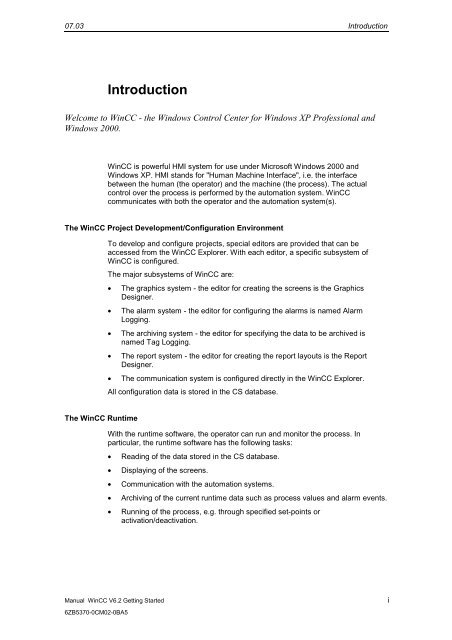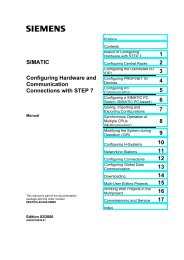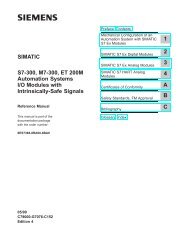WinCC V6.2 Getting Started - DCE FEL ČVUT v Praze
WinCC V6.2 Getting Started - DCE FEL ČVUT v Praze
WinCC V6.2 Getting Started - DCE FEL ČVUT v Praze
You also want an ePaper? Increase the reach of your titles
YUMPU automatically turns print PDFs into web optimized ePapers that Google loves.
07.03 Introduction<br />
Manual <strong>WinCC</strong> <strong>V6.2</strong> <strong>Getting</strong> <strong>Started</strong> i<br />
6ZB5370-0CM02-0BA5<br />
Introduction<br />
Welcome to <strong>WinCC</strong> - the Windows Control Center for Windows XP Professional and<br />
Windows 2000.<br />
<strong>WinCC</strong> is powerful HMI system for use under Microsoft Windows 2000 and<br />
Windows XP. HMI stands for "Human Machine Interface", i.e. the interface<br />
between the human (the operator) and the machine (the process). The actual<br />
control over the process is performed by the automation system. <strong>WinCC</strong><br />
communicates with both the operator and the automation system(s).<br />
The <strong>WinCC</strong> Project Development/Configuration Environment<br />
The <strong>WinCC</strong> Runtime<br />
To develop and configure projects, special editors are provided that can be<br />
accessed from the <strong>WinCC</strong> Explorer. With each editor, a specific subsystem of<br />
<strong>WinCC</strong> is configured.<br />
The major subsystems of <strong>WinCC</strong> are:<br />
• The graphics system - the editor for creating the screens is the Graphics<br />
Designer.<br />
• The alarm system - the editor for configuring the alarms is named Alarm<br />
Logging.<br />
• The archiving system - the editor for specifying the data to be archived is<br />
named Tag Logging.<br />
• The report system - the editor for creating the report layouts is the Report<br />
Designer.<br />
• The communication system is configured directly in the <strong>WinCC</strong> Explorer.<br />
All configuration data is stored in the CS database.<br />
With the runtime software, the operator can run and monitor the process. In<br />
particular, the runtime software has the following tasks:<br />
• Reading of the data stored in the CS database.<br />
• Displaying of the screens.<br />
• Communication with the automation systems.<br />
• Archiving of the current runtime data such as process values and alarm events.<br />
• Running of the process, e.g. through specified set-points or<br />
activation/deactivation.

















